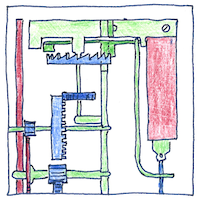Christiaan Huygens
horology

|
Pendulum clock
For centuries, clocks were regulated by verge escapements with a balance wheel or foliot, a horizontal bar with adjustable weights. A vertical rod with two pallets engage the teeth of a crown wheel to swing the wheel or foliot first in one direction from a pallet hitting a tooth at the top of the crown, then in the other from the second pallet hitting a tooth at the bottom of the crown. Galileo had investigated using a pendulum as a regulator. Around 1637, late in life, he invented an escapement. Since he was blind, he described it to his son, Vincenzo. Vincenzo began to build a clock of this design, but the clock was never completed. So Christiaan Huygens was the first to build a pendulum clock. He used the verge escapement and took a lot of effort with the math. He found that the ideal path of the swing isn’t a circular arc, but a cycloid, and he gave a formula for calculating the period for a pendulum of a given length. After the pendulum, Huygens invented the balance spring, a pendulum for a pocket watch. He didn’t know that Robert Hooke had already invented it fifteen years before.
Isochronism
Galileo Galilei, in 1581, was the first to discover that each swing of a pendulum took about the same amount of time whether swinging widely or narrowly. In his church in Pisa he counted the beats of his heart as a chandelier swung overhead. Each swing took the same number of beats when calmly swinging a few degrees or when pushed by a gust from an open door.
The tautochrone problem
The path of a pendulum is not exactly isochronous; that is, wider swings are slightly faster. However, Huygens showed that a cycloid path is isochronous, which is interesting because Galileo studied the cycloid, although he failed to determine its area. Huygens also showed how to correct the path of a pendulum, suspending the pendulum from a string that is constrained by cycloidal curbs. Too bad this design did not result in a more accurate clock. The improvement in timing for getting rid of the circular error was offset by the energy it took to bend the string, at least for small swings, where the difference between circle and cycloid is very small.
Escapements
Various variations of the verge escapement were used in pocket watches and clocks, including turret clocks across Europe, since the fourteenth century. The verge escapements continued to be used after the pendulum replaced the foliot or balance wheel. A verge escapement allows a clock driven by a spring to slow down as the spring unwinds. It also causes recoil, driving the crown wheel backward a little during each tick and tock. Furthermore, when regulated with a pendulum instead of foliot, it swings the pendulum as much as eighty to a hundred degrees. Robert Hooke invented the anchor escapement around 1657, reducing the swing of a pendulum to as little as three degrees, thereby reducing error due to the tautochrone problem, but this escapement still produces recoil. In 1675, Richard Towneley invented the deadbeat escapement, which is an anchor escapement designed to eliminate recoil by adding locking faces to the impulse faces at the ends of the anchor. The pin wheel escapement is a robust version of the deadbeat escapement used for turret clocks. The gravity escapement, developed over a hundred years from around 1750 by many including Bloxam and Lord Grimthorpe, was used in turret clocks because its rate is unaffected by variations in the forces on the gear train. John Harrison invented the grasshopper escapement in 1722. This escapement requires no lubrication and has two pivoting levers that alternately arrested the escape wheel. Subsequently, Harrison invented the gridiron pendulum and competed for the Longitude prize with his “sea watches.” Many escapements were designed for pocket watches. Thomas Tompion invented the cylinder escapement in 1695, Thomas Mudge invented the lever escapement in 1750, and Thomas Earnshaw perfected the detent escapement around 1800. Robert Hooke invented the duplex escapement around 1700, which provides separate sets of locking and impulse teeth and provides an impulse to the balance wheel only during its counterclockwise turn. Improvements in escapements included decreasing the degrees of swing, and detaching the movement of the pendulum or spring wheel from the gear train, isolating the escapement from variations in drive force. eliminating recoil or backlash, and reducing friction. In general, we want to reduce wear and improve isochronism. For pocket watches we also want a self-starting escapement. Many more escapements have been invented, including several for decorative and wooden clocks. For people today, more accustomed to clocks with quartz movements, it’s important to note that escapements allow the gear train of a clock to escape only in rhythm to the swing of a pendulum or balance wheel.
Pendulum and pendula
Swingers were married people who took other partners, and swing dancing was like square dancing only not for squares. We were in the Cold War. The Vietnam war had not begun. The nation swings to the right, then it swings to the left. We repeat mistakes that we have forgotten from our brief history. We restage the great works of the Victorian Age. Retro is in fashion; rhymed verse has come back as rap lyrics. I thought that Darwin had settled the matter of natural selection. I recognize that some people have a different opinion, but opinions cannot change reality, nor the lessons of the past. I still believe people have a responsibility to create their own culture, not to get the money to buy it. It seems to me that I’ve become an old fart, but I’m betting that being an old fart is coming back.



The area under a cycloid is exactly three times the area of the circle that is used to generate it. Galileo compared these areas by tracing the curves on sheet metal, cutting them out, and weighing them, but his result was about 3.1, so he mistakenly concluded that the ratio was irrational.
Christiaan Huygens’s father, Constantijn Huygens, was a friend of Marin Mersenne, Descartes, and Galileo. So it is interesting to inquire how many of his interests Christiaan picked up from them. Descartes invented analytic geometry; Christiaan taught analytic geometry to Leibniz. Mersenne was interested in music theory and so was Christiaan, who rediscovered 31 equal temperament. Mersenne and Galileo were interested in vibrating strings and in the cycloid, and so was Christiaan. Galileo was interested in the pendulum and using it to regulate a clock and so was Christiaan. Galileo improved the telescope and so did Christiaan. Galileo was the first to observe the rings of Saturn and Christiaan was the first to identify them as rings. Furthermore, as a student, Christiaan corresponded with Fermat, who with Pascal invented probability theory; well, Christiaan wrote the first book on probability theory. But Christiaan Huygens was also important in the development of the internal combustion engine; Denis Papin was his assistant at one time. Papin contributed to early steam engines.
See also in The book of science:
Readings in wikipedia: